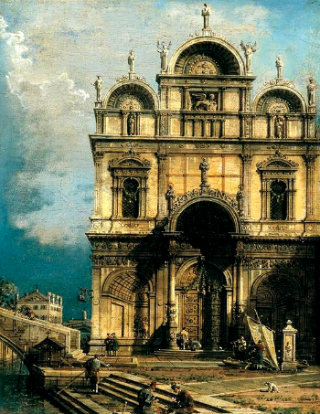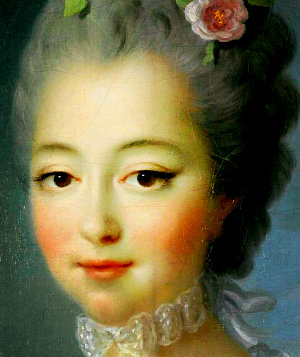Canaletto
also known as Giovanni Antonio Canal
1697-1768
Italian Rococo Painter
Artistically and stylistically influenced by the following painters; Titian, Gian Paolo Panini, Jacopo Tintoretto and Sandro Botticelli
Education -worked and in his fathers studio, Bernardo Canal and later studied under Gentile Bellini and Giovanni Bellini
Cause of Death - stroke
technique - oil on linen or oak panel

Despite Canaletto's considerable knowledge of and borrowings from old masters, he remained in the last analysis a Rocco painter through and through. His diaphanous golden lighting of Italian landscapes carries the assurance of an artist saturated with the Mediterranean tradition. His dramatic, velvety application of paint and skillful depiction of nature have a freshness and liveliness unequaled in the work of any of his contemporaries. Canaletto lived during exciting and restless times. The world was in transition. Europeans were changing with the development of an intellectual movement called "The Enlightenment". Writers and artists grew uneasy at the all-pervading censorship by the monarchy and church. People were becoming resentful over paying taxes to support a wealthy, absolutely useless aristocracy.
People were becoming fascinated with science, art and new philosophies. The power of the clergy and landed gentry began to gradually weaken. Italy in Canaletto's time was relatively free of strife. He opposed tyranny and dogma, devoting his life to capturing the noble beauty of Venice. He loved painting in the early morning hours, capturing the old world splendor of cathedrals and weather beaten palaces. Canaletto is most remembered for his gift at depicting glowing light spreading over water.
'
 Rocco
paintings feature beautiful aristocrats decked out in velvet, elegant
laces and rich golden embroideries. The figures are tall and willowy,
stylish and charming. The faces are presented as soft and rosy,
effeminate and eternally young. Noblemen are depicted wearing feminine
coiffeurs, rouged lips and cheeks, often sporting high heels. In a way
they resemble modern day drag queens. The Rocco female figures are
delicate and light; the faces, are childish and sentimental. The lines
of the mouth curve in soft mischief or in a delicate enchanting smile.
Rocco
paintings feature beautiful aristocrats decked out in velvet, elegant
laces and rich golden embroideries. The figures are tall and willowy,
stylish and charming. The faces are presented as soft and rosy,
effeminate and eternally young. Noblemen are depicted wearing feminine
coiffeurs, rouged lips and cheeks, often sporting high heels. In a way
they resemble modern day drag queens. The Rocco female figures are
delicate and light; the faces, are childish and sentimental. The lines
of the mouth curve in soft mischief or in a delicate enchanting smile. Characteristic of Rococo art was paintings of carefree aristocrats at play in make-believe settings. These romantic scenes depict luxuriously costumed ladies and gentlemen flirting, picnicking and playing music at gallant country parties. The background scenery is often a serene natural setting with delicate trees and sprays of roses. Colors are a profusion of soothing, light pastels. The Rococo movement was initially restricted to France, later spreading to all of Europe and above all to Germany. The movement continued to develop until the arrival of Neoclassicism which attempted to return to the purism of classical antiquity. Principle Artists of the Rococo Period Pompeo Batoni Italian,1708-1787
Bernardo Bellotto Italian,1720-1780
Francois Boucher French, 1703-1770
Canaletto Italian, 1697-1768
Jean-Baptiste Simeon Chardin French, 1699-1779
Jean-Honoré Fragonard French, 1732-1806
Thomas Gainsborough English, 1727-1823
Francisco de Goya Spanish, 1746-1828
Thomas Hudson English,1701-1779
Jean-Marc Nattier French, 1685-1766
Joshua Reynolds English, 1723-1792
Paul Sandby English, 1730-1809
Jean Antoine Watteau French, 1684-1721
Require more information about the famous Italian Rococo landscape painter Canaletto in Art History? Type your query in art into the google search box below and poke around every nook and cranny of the known universe for information this subject.
© HistoryofPainters.com If you like this page and wish to share it, you are welcome to link to it, with our thanks.
If you feel you have worthwhile information you would like to contribute we would love to hear from you. We collect essential biographical information and artist quotes from folks all over the globe and appreciate your participation. When submitting please, if possible, site the source and provide English translation. Email to millardmulch@gmail.com
| links | artist biographies | top 50 painters | art supplies | book store |
| site map | art movements | artist quotations | iconography | 100 greatest paintings |
Painters by Country
Painters by Century
Painters by Movement
Symbolism